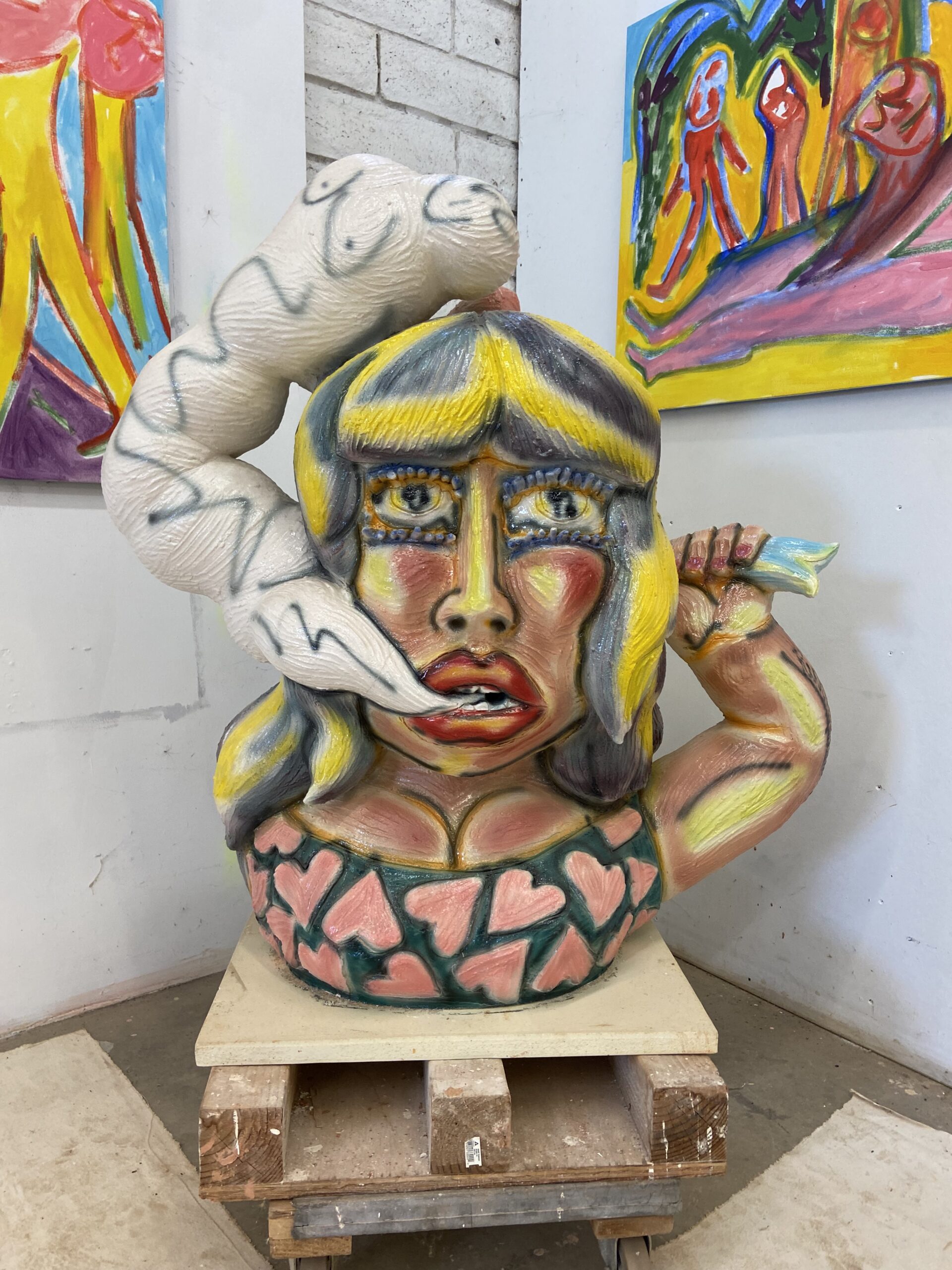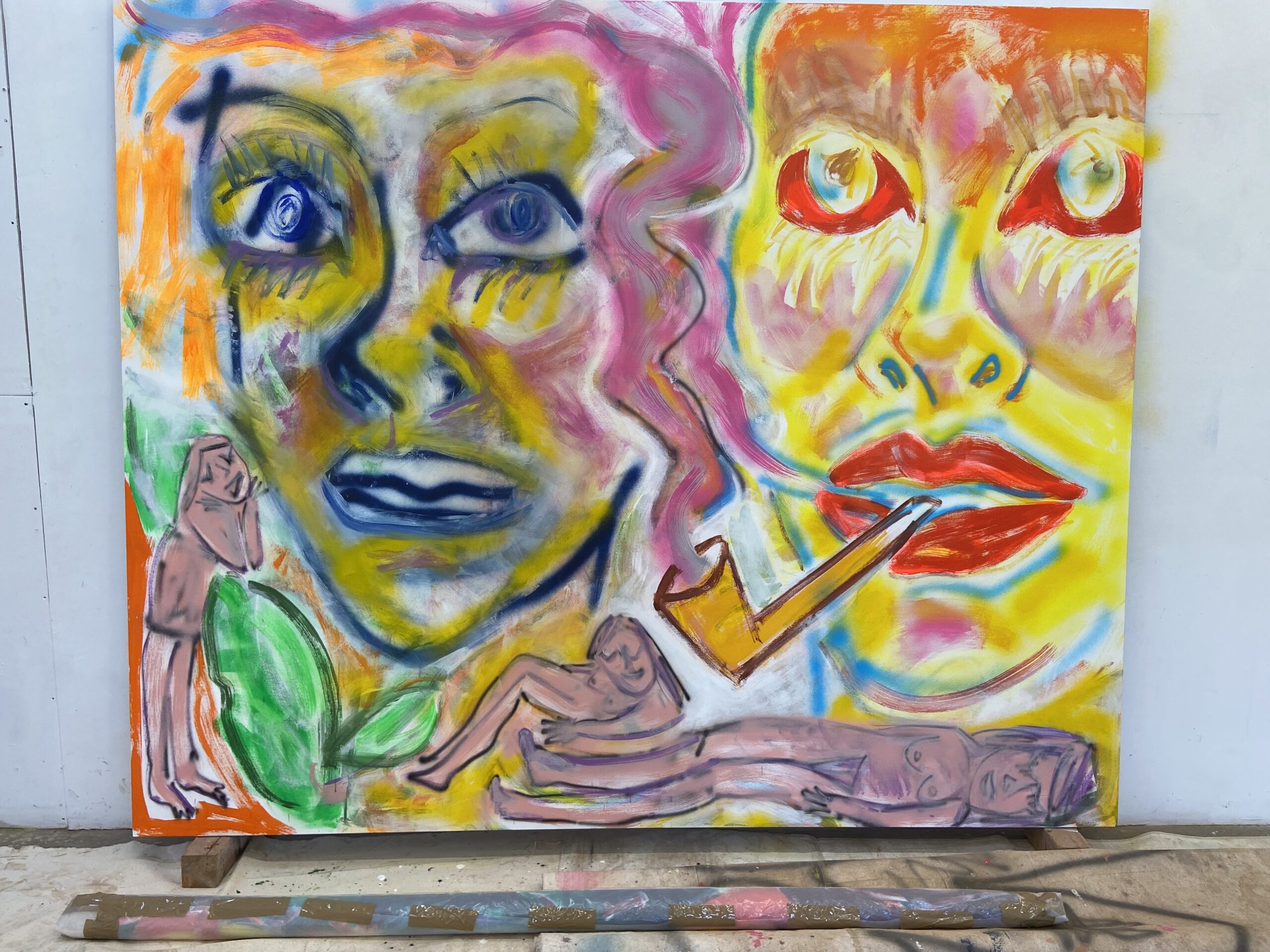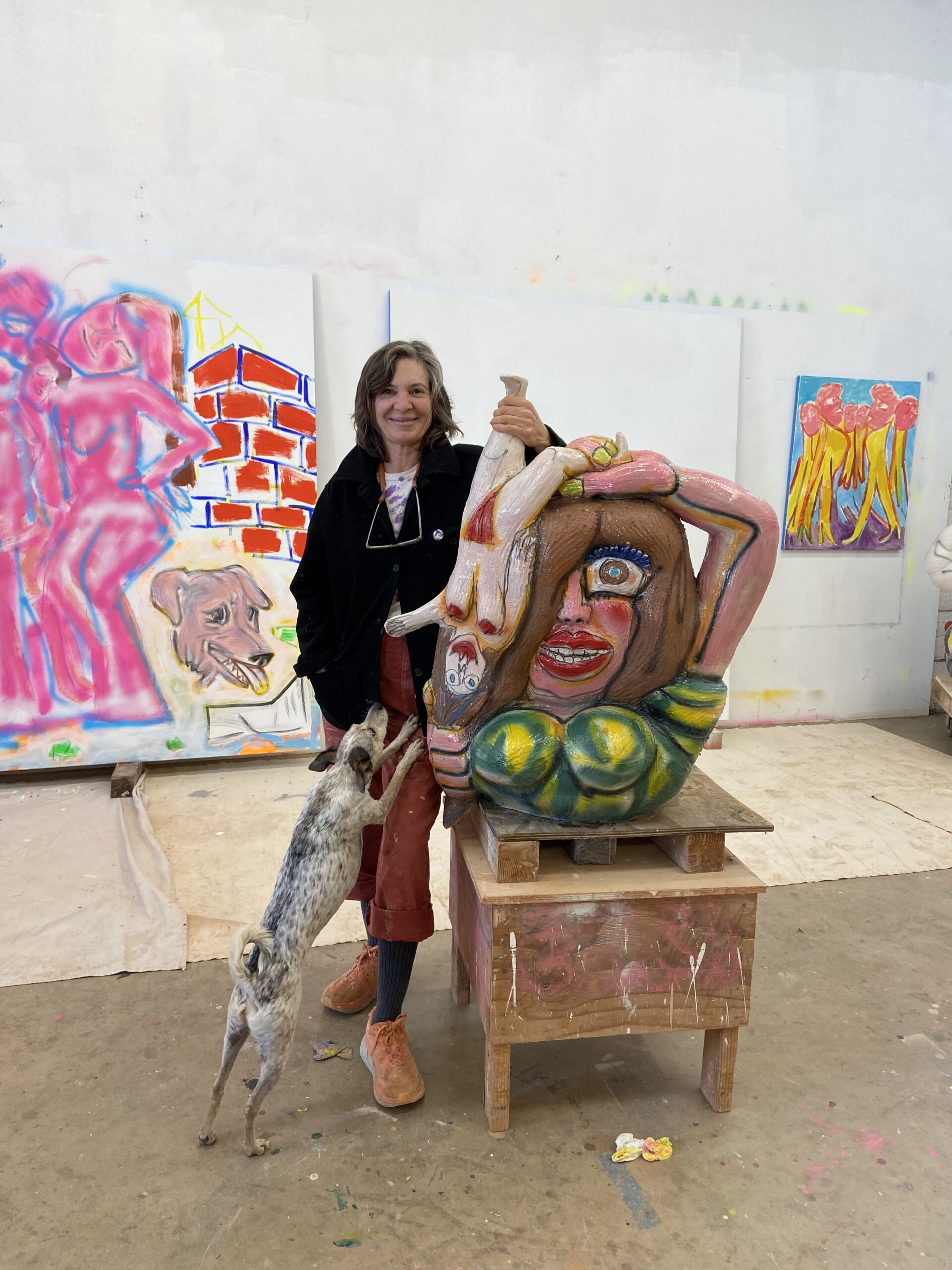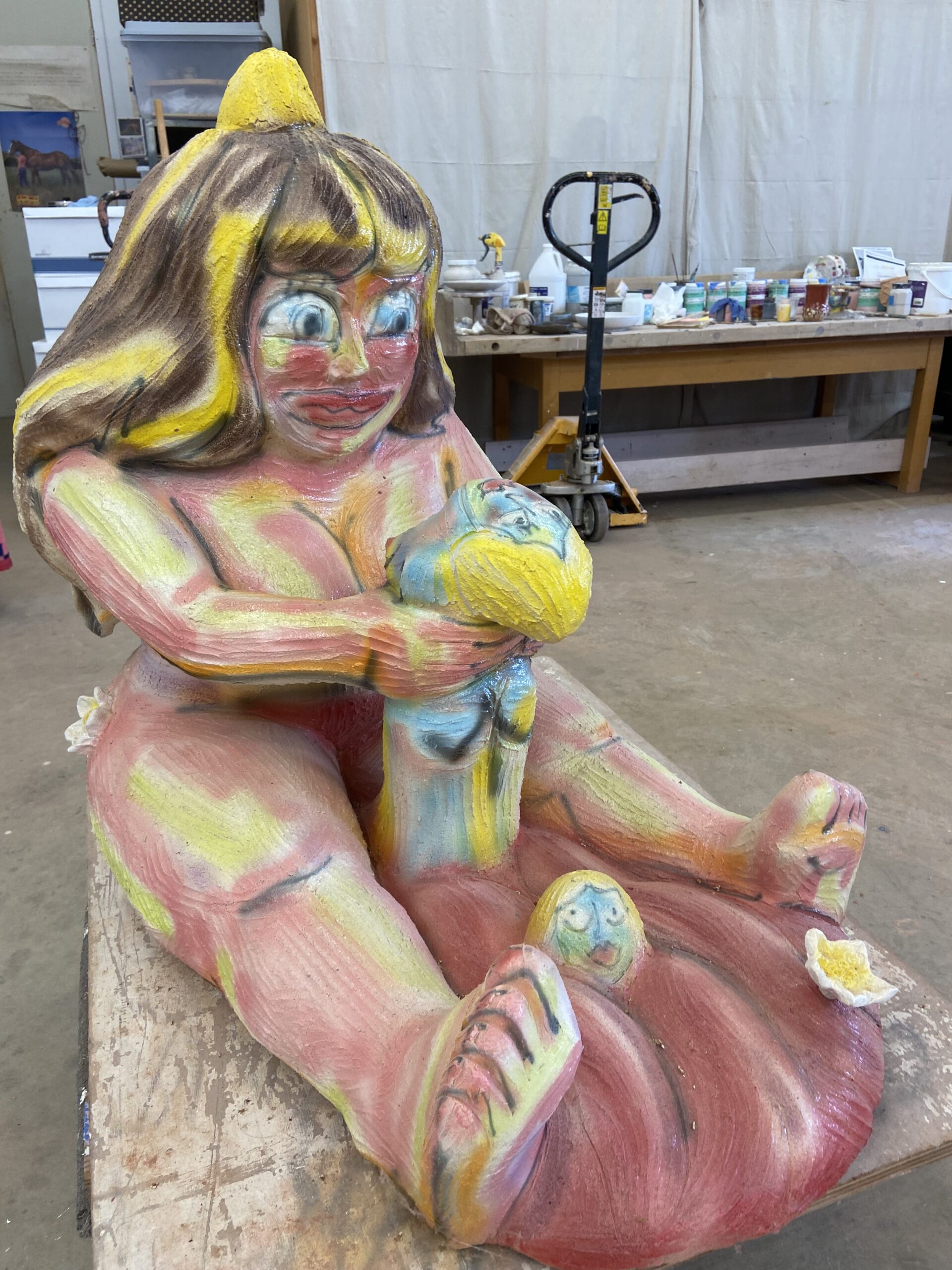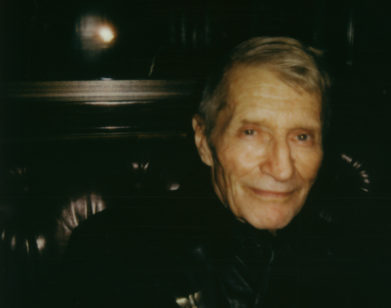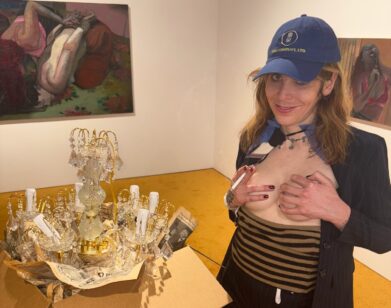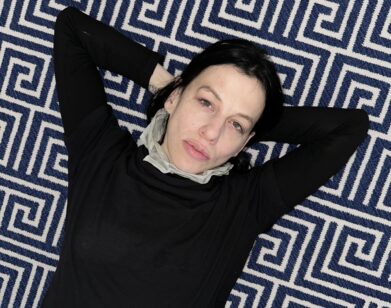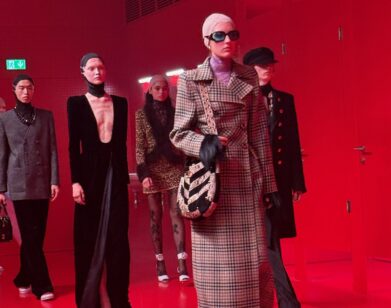STUDIO VISIT
Artist Ruby Neri on Motherhood, Primal Urges, and Her Buxom, Bronzed Sculptures
Spend just five minutes with the Los Angeles-based artist Ruby Neri, and you’ll be absolutely charmed. “I can’t really sit still,” she says before jumping up to grab a Topo Chico. Then, a bottle opener. Then, a paper towel. Neri radiates the kind of kinetic energy that animates everything around her, including the statuary strewn about her spacious studio. What people mourn when they mourn the end of childhood is the loss of such unabashed vitality. As she bounds between the various vividly painted female figures, her dog Lucy trailing close behind, you’d swear the ceramics were moving, too.
“I was a diehard Interview fan as a teenager,” she said while shaping a woman’s face from red clay. “I still have a bunch of my old issues from the ‘80s.” Neri’s horse, she went on to reveal, was named after Andy Warhol, and its show name was Interview. But perhaps this admission isn’t so surprising considering the fact that Neri was a central member of the Mission School, a group of counterculture street artists in the Bay Area. She spent the early ‘90s studying at the San Francisco Art Institute and spray painting fluorescent herds of wild horses on derelict buildings and unfinished bridges under the moniker Reminisce. Hence, the title of her forthcoming monograph: REMINISCE San Francisco 1992-1996.
Three decades later, Neri’s horses are still on the run. Though she’s traded train cars for hand-built ceramics, bronze sculptures, and fine paper for her solo show at David Kordansky Gallery, on view until December 14th, Neri’s line remains just as dynamic and free. On the eve of the exhibition’s opening, and while already at work on her next show at the Manetti Shrem Museum of Art in Davis, California, she spoke to me about the pleasure and perils of her compulsive drive to create.
———
TARA ANNE DALBOW: I read that you always want your work to be physically challenging.
RUBY NERI: Yeah. I know it’s an extreme sort of quote, but I’m totally sure I said that. I like it to be a physical interaction, but it’s also very much about accessible materials. Like, materials that I could just pick up and start working with right away. I feel like that’s why I did graffiti, and that’s why I did painting and clay. With graffiti, not only is a can of spray paint super accessible, but it’s a full-body movement, and it’s an action in a sense.
DALBOW: Is that an expression of energy?
NERI: I think it’s a little bit of that—and ADHD, or just not really being able to sit still. I don’t do a lot of conceptual thinking or downtime. I don’t really like those long in-between periods with making things. The physical appeal of the material is really important to me, the physicality and the tactility. I really approached painting like that for a long time, especially with oil paint. It’s very thick and tactile, but the color is this kind of energy spark as well. All these things are sort of about energy and movement and flow.
DALBOW: How does that change between mediums?
NERI: It’s all very connected, I feel, especially through color and texture. One of the questions you sent was about fertility. It’s so funny because they’re not really goddesses or fertility figures. They’re almost like, the after-effects of fertility. It’s like, “Oh my god, what do I do with this baby?” It’s like the challenging aspect of being a parent or having dependents. It’s not so much about the fertile moment; it’s about the day after or the hangover.
DALBOW: After you’ve created, or—
NERI: Yeah, a result of that. I also love this fractured character that I’m working with from a biographical perspective. It’s like all these elements of my brain. There’s a main character, perhaps, and then there’s these satellite characters that have all the elements from a day in them: there’s struggle, there’s peace, there’s happiness. What I mean about sexuality, and it’s easy to see in a piece like this, is it’s dependent on who is in control. Like being a parent, your kid has so much control over you, but you have control over the kid, too. It’s this duality of energy that’s really beautiful. That’s my interest in including multiple figures, basically; showing all these elements of one personality. It’s funny because people are always like, “You hate men, you’re never including men,” but it’s about my brain and what’s happening with my own personality, so to speak.
DALBOW: Right. You’re not a man.
NERI: Yeah, for sure.
DALBOW: I was just thinking, there are so many writers who say they write the same sentence over again for their entire lives, painters that will say they’ve been painting the same painting their entire lives. You’ve been tackling women’s subjectivity, power imbalances, and gender dynamics for a while. I’m wondering what’s evolved and what’s stayed the same as you’ve progressed.
NERI: There’s definitely some sort of comfort in working very slowly through subject matter because I don’t want to be rushed through ideas and places. I feel like I’m such a schizophrenic maker. I can go through things really quickly. I can make a sculpture for an hour, and then I can go and paint on something and then start making drawings. So, it was a really enlightening moment when clay captured my attention for as long as it did. The structure that clay gives me is actually really stabilizing and grounding.
DALBOW: Because it sustains your focus, your energy?
NERI: Yeah. There are so many limitations with working with clay that you have to think about, and there’s a lot of forethought and planning going into a piece, but it was kind of a pleasurable challenge as opposed to building armatures. That was really annoying to me, but the clay really held my attention. And I like the idea of evolving through this really simplistic subject matter. There’s all these little figures that I like to keep moving around.
DALBOW: So it’s more of a deepening of these initial ideas as opposed to expanding to include other things or moving on to something else?
NERI: I mean, I love to think about the timeframe of a life and not having to rush through things. I don’t really want to go through ideas too quickly. Being a parent and being confined to the 9-5 time period of making art is really challenging. There’s never enough time, and there’s so much I want to make. I feel like if I didn’t have a kid, I’d be a total recluse making work 24 hours a day or something. So, I try to hold onto the longevity of life for a moment and take a deep breath to counter that sense of there being not enough time left.
DALBOW: Do you have a sense of where that unrelenting will toward creation comes from?
NERI: It is a really potent drive in me. It’s sort of like when you watch nature shows—the urgency of creating life is so intense in nature. And I’m not saying that’s what drives my art-making, but there’s definitely a life-force in making. It’s also very soothing to make artwork. It’s like a happy place for me. It goes back to when I did graffiti. I feel like people that do graffiti are kind of weird. Not only are they kind of anti-social, but they’re obsessive, like they have to pick up that spray can and do that sort of movement.
DALBOW: It’s like a compulsion.
NERI: For sure. Also, I don’t think I could do anything else very well. It’s a really, really rewarding pastime. I love to look at other artwork, and then I get this intense energy to go back to my studio and make things. It’s this weird physical urge.
DALBOW: I get that with writing. I read something I really love and then have to immediately go write.
NERI: It’s really intense that way.
DALBOW: What’s happening with these stacked women?
NERI: Well, it’s funny, it’s really common for me to make stacked figures. It’s not a new composition or concept. But I really liked working with Stuart Krimko on the press release. He’s actually the one who started talking about how the staircase is an in-between area: the up and the down or the bottom and the top and heaven and hell. So when he started talking about it that way, I was like, “Wow, you’re totally right.” And then I put the others on the bridge. I liked the idea of it being about an intermediate space.
DALBOW: Like a purgatory?
NERI: Totally. Like an endless wandering between, that would definitely be torture. But yeah, there’s definitely a lot of those in-between areas or forked roads. It could be this way or that.
DALBOW: Is it better to be on top or bottom? Or do they both come with their own struggles and problems?
NERI: They’re both equally fraught with their different issues, for sure. I like that nuanced space. I don’t really like to be hemmed in by a strict structure in terms of an overarching theme with shows. But I definitely see shows as bodies of work from a certain time in my life. I mean, this one is rather fractured because I’ve been doing so many ceramic shows, and I haven’t shown flat work or a bronze sculpture altogether in a long time, so that’s kind of a breath of fresh air for me.
DALBOW: Does that change the overall rhythm of the show for you? Or how do you relate to being in that space with all those different mediums?
NERI: I actually feel like it shows more of my practice as a whole. I’m working like that all the time in my own private space. I think it’s probably more difficult for my gallery, actually, to have all those different elements. But I love to think about all the different shows and installations that are possible, and I’m looking forward to my next show already.
DALBOW: How does freedom come into play? I feel like there’s this material freedom, and also this expression of freedom as a woman with many different parts, there’s sexual, intellectual, and physical freedom.
NERI: Definitely. I mean, I’m constantly grateful for the freedom to be making artwork as much as I do. I’d probably shrivel up and die if I couldn’t. It goes back to the control issue. Sometimes, I consciously think that I have to let the material be the part that’s free. Like I need to let the material do its thing because if I overthink stuff too much, it really fucks it up. It’s a little complicated to talk about, but it’s kind of like trust. I used to ride horses, and I would think about that dynamic a lot. It’s really symbiotic, you know what I mean? It’s like you can’t really control them. You have to let them lead themselves. And it’s a really shared, reciprocal relationship, and you have to make sure that it’s copacetic. And I feel the same way about materials when I’m making things.
DALBOW: Does that carry into the content like with these female figures, or is their liberation different?
NERI: I’m never consciously thinking, “Sexual rights for all!” I don’t have a heavy-handed sort of ideology about the imagery that I’m making. It took me forever to think of myself as a feminist.. The images come from somewhere inside of me that I don’t really have to think so much about, like organic gut feelings. It’s just all a part of me being a woman in the world. I’m not fighting for sexual freedom or rights or what have you. I think they are just inherent in me, to begin with, so they naturally come out in the work. They are all definitely very personal.
DALBOW: Do you think of your unconscious coming into play? Or is it more responding to something about the material that’s really outside of yourself?
NERI: I think a lot of my work is based on me being a parent and having a kid that I’m caring for. I find it to be a really challenging part of the world. I didn’t really start making work like this until I had my kid. It was sort of life-changing in a weird way. I mean, people say that all the time: “Oh, I had a kid, and my life changed.” It’s like, yeah, you have to grow up, but it’s more than that I guess having a kid really showed me all the restrictions within society, especially on women, and all the expectations put on parents. The struggles of parenting and domestic domains and just being a partner with someone and raising someone became really apparent. It’s really complicated and difficult. I think there’s more of that in my work than there is just straight-up female sexuality, you know what I mean? I feel like biology and sexuality are what get you a kid, but what defines me more as a woman is being a parent.
DALBOW: Do you feel like you’re reckoning with that when you’re making art?
NERI: I mean, not so literally. I think it just comes out, it’s kind of like an exorcism. I feel like I’m a really basic person. I’m just sort of making work from a very basic, deep place within me. That’s what I mean in terms of being really murky and sort of containing all these characters and body fluids and sexuality and things that are really primordial and primal. And it’s really crazy, especially when we’re so biologically wired to reproduce and procreate. From my perspective, as a woman, it’s really complicated. I mean, I find just being a member of society really complicated and challenging. I am hoping to show some element of that complexity. There’s no right or wrong way.
DALBOW: There’s something brave about that. And I know that word’s loaded, but I think right now there’s a lot of pressure at least on women making art, myself included, to be representative of something and to be pushing some agenda. Whether you’re intentionally trying to resist that pressure and that narrative or not, it’s still there. So, I really appreciate your willingness to get beyond that and let your experience with the material and your process be the dominant creative force.
NERI: Well, it’s funny that you say that because I always felt like I could never articulate my political views like I feel really put on the spot in terms of taking a standpoint. I always felt like the dumbest person in the room. In terms of intellectual discourse, all I can do is work through it I don’t know if it’s generational, but I feel like younger people can articulate themselves so much better. They just have this knack for discourse, or what have you.
DALBOW: I think we could probably use a lot less talking and intellectualizing at this point.
NERI: This is just the best way I can express myself. And it’s really important to add that I can’t speak for anyone else out there. This is my experience. These are the feelings that I have about my place in the world as a woman. This work is about really basic things, the domestic sphere, and the complexities of that. It’s weird because I feel like people are thinking so much about existential stuff, but the most basic shit in life is really difficult.


